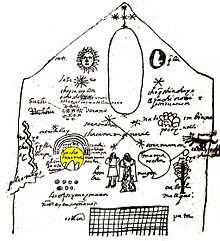Pachamama

Pachamama é unha deusa adorada polos pobos indíxenas dos Andes. Tamén é coñecida como a nai da Terra e do tempo.[1] Na mitoloxía inca, Pachamama é a deusa da fertilidade que preside o cultivo e a colleita, encarna as montañas e produce os terremotos. Ela tamén é unha divindade sempre presente e independente, que ten o seu propio poder creador para soster a vida na Terra.[1] Pachamama é a muller Pacha Kamaq e os seus fillos son Inti, o deus do Sol, e Killa, a deusa da Lúa.[2] Na cosmoloxía quechua, hai catro principios básicos da natureza baseados na auga, na terra, no Sol e na Lúa.[2] Despois da conquista dos españois, que forzaron a poboación a converterse ó catolicismo, a figura da Virxe María unificouse coa de Pachamama para moitos pobos indíxenas.[3]
Notas
[editar | editar a fonte]- ↑ 1,0 1,1 Dransart, Penny. (1992) "Pachamama: The Inka Earth Mother of the Long Sweeping Garment." Dress and Gender: Making and Meaning. Ed. Ruth Barnes and Joanne B. Eicher. New York/Oxford: Berg. 145-63. Print.
- ↑ 2,0 2,1 Matthews-Salazar, Patricia. (2006) "Becoming All Indian: Gauchos, Pachamama Queens, and Tourists in the Remaking of an Andean Festival." Festivals, Toursism and Social Change: Remaking Worlds. Ed. David Picard and Mike Robinson. N.p.: Channel View Publications. 71-81. Print.
- ↑ Merlino, Rodolfo y Mario Rabey (1992). "Resistencia y hegemonía: Cultos locales y religión centralizada en los Andes del Sur". Allpanchis (en castelán) (40): 173–200.
Véxase tamén
[editar | editar a fonte]| Wikimedia Commons ten máis contidos multimedia na categoría: Pachamama |
Bibliografía
[editar | editar a fonte]- Dransart, Penny. (1992) "Pachamama: The Inka Earth Mother of the Long Sweeping Garment." Dress and Gender: Making and Meaning. Ed. Ruth Barnes and Joanne B. Eicher. New York/Oxford: Berg. 145-63. Print.
- Hill, Michael (2008) Inca of the Blood, Inca of the Soul: Embodiment, Emotion, and Racialization in the Peruvian Mystical Tourist Industry. Journal of the American Academy of Religion 76(2): 251-279
- Hill, Michael D. (2010) Myth, Globalization, and Mestizaje in New Age Andean Religion: The Intic Churincuna (Children of the Sun) of Urubamba, Peru. Ethnohistory 57(2):263-289
